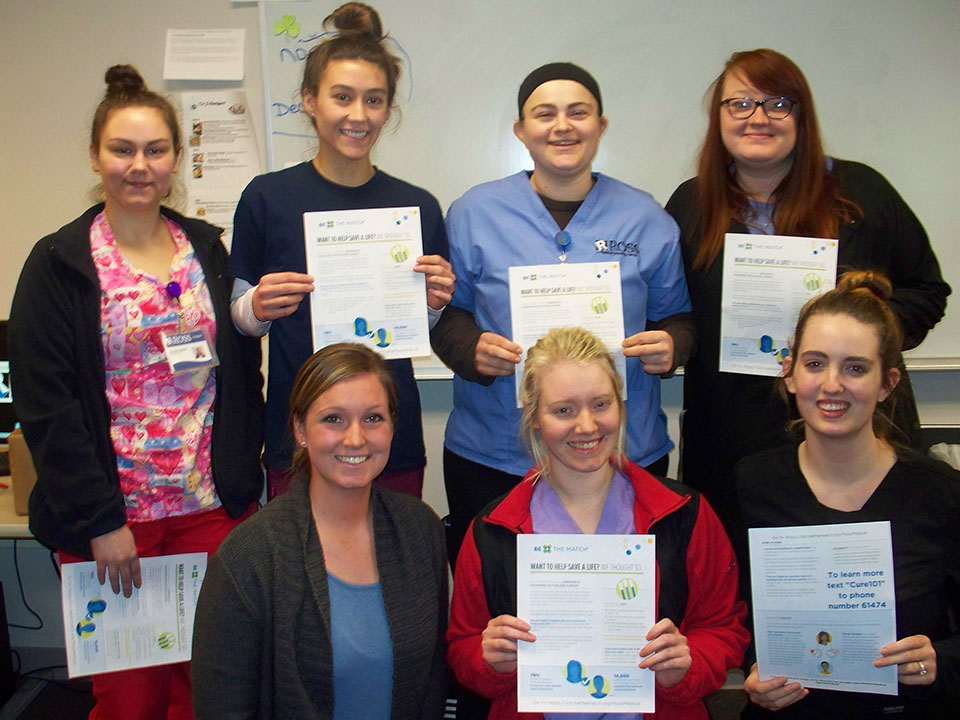Be The Match is a national organization which works to help patients with blood cancers find stem cell and bone marrow donors. For the past 30 years, the organization has managed the largest and most diverse marrow registry in the world.
This past December, Ross Medical Education Center of Lansing welcomed guest speaker, Mackenzie Ganzak, of Michigan Blood’s Be The Match Organization to the campus. Mackenzie has visited the Lansing campus several times over the past few years, each time moving staff and students to tears with her heartfelt presentation.
Ganzak explained Be The Match’s profound need to include donors from diverse ethnic backgrounds in their registry. Seventy percent of patients needing a marrow transplant do not have a fully matched donor in their family. That translates to 14,000 patients per year whose only hope for a cure is a transplant from someone outside of their family. “Patients have a different chance of finding a match based on where they come from because we are looking so much deeper than just blood type. We’re also looking at DNA and tissue types, which are passed down from generation to generation,” stated Ganzak.
The students really enjoyed the presentation. They were eager to learn how they could register for Be The Match and potentially save the life of a terminally ill patient. Many signed up immediately following the presentation. Senior Medical Assistant student, Abigail Casimir, shared her thoughts on being a potential donor: “Be The Match inspired me to take part in the donor registry. I believe making a donation is a brave and outstanding act of kindness. It would make such a difference in my life to donate to somebody who is in need. This also reminded me that there are people who face fatal illnesses; if everyone takes part in the registry, we can really help those in need.”
When a patient is sick and the doctor has decided that a bone marrow transplant is the way to go, the registry starts looking for a match immediately. Once a match is found, treatment begins. First, the patient goes through very rigorous chemotherapy and radiation to get rid of the cancer. The new cells are then brought in and transfused in the patient’s body. The idea is that the donor cells completely take over the patient’s body. Eventually, the cells will stop producing its own and only produce the donor’s cells.
If a patient goes through chemotherapy and they wipe out the cancer, relapse is possible later down the road. If that’s the case, the doctor is going to look at possibly having a bone marrow stem cell transplant. It’s not the first choice for doctors, but it has been effective for many individuals.
As is the case with every procedure, there are risks. A bone marrow transplant is different than any other transplant. If an organ transplant is performed and the patient’s body rejects it, the organ can be taken out. However, if the body rejects the bone marrow or stem cells, doctors are not able to take it out because it becomes like the blood.
On the contrary, a bone marrow transplant can be life-changing for some patients. It can replace diseased or damaged marrow with new stem cells, the new stem cells can help kill cancer cells directly, and it can make treatments such as chemotherapy or radiation much safer and easier for patients because the new cells replace or rescue the bone marrow damaged by treatment.
Signing up doesn’t necessarily mean donating will occur. One will typically fill out a profile online, swab the cheeks, and then those swab kits are sent into the lab to be tested. The people are then put on the registry so they’re searchable. Only about one in 430 people on the registry go on to donate.
There are two different ways people donate. Most of the time, they donate stem cells, which looks very similar to donating plasma or platelets. Five days before their donation, they get an injection of a medication that will tell their bone marrow to create more blood-forming cells. On day five, the donor goes to a clinic and the blood is drawn. Some of the blood is removed through a needle in one arm and passed through a machine that separates out the blood-forming cells. The remaining blood is returned through the other arm.
The other way to donate is through a surgical, usually outpatient, procedure. The patient will receive anesthesia and doctors use a needle to withdraw liquid bone marrow from the back of the pelvic bone. Patients will typically experience some soreness after the procedure.
The stem cells that are taken from the patient typically regenerate within a few weeks. If someone is a match, they can donate up to three times in their lifetime. However, most only donate once.
To learn more about Be The Match, please visit https://bethematch.org/.
